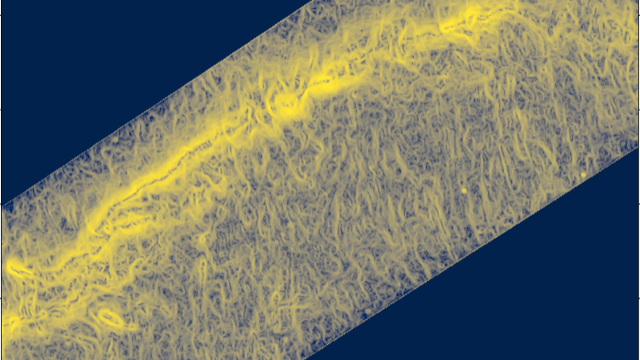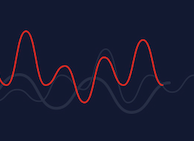
An astrophysics project bringing together French and German researchers
Astronomy & Astrophysics (A&A), a leading international astrophysics journal, recently published a noteworthy article exploring one of the main results of the GENESIS project. Bringing together the GeoStat project team from Inria Bordeaux – Sud-Ouest, the Bordeaux Astrophysics Laboratory and the institute of astrophysics at the University of Cologne, the aim of this project was to understand certain mechanisms involved in the formation of stars, focusing in particular on the role played by turbulence in this process, using signal processing. Turbulence refers to the motion of a liquid or a gas characterised by different sizes of eddies, like clouds of smoke from a cigarette, for example.
Launched in 2017 by Nicola Schneider, a researcher in astrophysics at the University of Cologne, and Sylvain Bontemps, an astrophysicist at the Bordeaux Astrophysics Laboratory, GENESIS ran within the context of a partnership funded by the German Research Foundation (DFG), the French National Research Agency (ANR) and the Nouvelle-Aquitaine region. The project came to an end in 2021 for the French teams, while the German researchers will end their contribution next year.
The mysteries of turbulence - a complex but universal phenomenon
Hussein Yahia, head of GeoStat, explains Inria’s contribution to the project: “In our team, which specialises in applied mathematics, we develop signal processing methods and focus on ideas taken from ‘statistical physics’. We also work on models which can be used to understand complex physical phenomena, such as turbulence, through analysis of data taken from observations, experiments or simulations. These research topics and our expertise attracted the interest of my astrophysicist colleagues in Bordeaux and Cologne.”
A difficult phenomenon to elucidate, turbulence is encountered in fluid flows. On Earth, for example, it plays a vital role in the dynamics of the atmosphere and the oceans, affecting planes and ships at sea. In space, turbulence can be observed in the gas clouds in which stars are formed, or in the atmosphere of certain planets, like in Jupiter’s famous red spot. A turbulent flow contains turbulent structures of various sizes (physicists refer to large or small-scale), and how this evolves over time or is distributed within space continues to intrigue scientists.
Studying turbulence in order to understand the formation of stars
Turbulence continues to be misunderstood, given the gap observed between the injection of energy at a large-scale and the dissipation of this energy at a small scale
explains Sylvain Bontemps. Its intrinsically multi-scale nature requires specific mathematical and statistical analysis methods, which are not yet effective enough to grasp its properties properly or the consequences it has on the affected environments.
Understanding the turbulent dissipation of energy in the interstellar medium is essential in order to explain the formation of certain stars. Sylvain Bontemps continues: “Without dissipation, the kinetic energy from major movements of the galaxy would be 10,000 times too big for the material to be able to collapse and form stars.” The astrophysicists sought to identify the origin of stars in the details of turbulence. Thanks to the Herschel satellite, which carried out in-depth observation of the interstellar medium around the Sun, they were able to collect the data they needed in order to study the turbulence that gives birth to stars.
Interpreting satellite images using original signal processing methods
Nicola Schneider
“Satellite images contain an enormous amount of information which can help us to understand turbulence. But unlike data on turbulence on Earth, which has very short characteristic times (less than a second) but which gives us rich temporal sequences, interstellar turbulence is much slower, taking place over thousands of years. Plus, in astrophysics, you only have access to one image”, explains Hussein Yahia. “What you have to do is to use this single map showing the spatial distribution of the turbulence to work out how it has evolved over time and to identify the energy dissipation mechanisms.”
The statistical methods developed through GeoStat, in particular the so-called “microcanonical” method, have shown that they are up to the task, having been used to link the statistical properties of signals to the traces of certain physical phenomena, and thus to quantify these phenomena. “We have been able to identify particular areas, filaments of interstellar gas, within which the turbulent dissipation is concentrated”, explains Nicola Schneider.
Statistical methods and astrophysics: highly encouraging results
By working together within the context of Lars Bonne’s PhD at the Bordeaux Astrophysics Laboratory, the researchers were able to develop a scenario explaining how these filaments are formed. “Different physics are observed in the interstellar medium: other than gas flows, magnetic phenomena come into play (astrophysicists refer to “magnetohydrodynamics”, Ed.) explains Sylvain Bontemps.
We established that magnetic phenomena play a major role in interactions between turbulent scales and in the accumulation of material within filaments
This discovery, which was covered in the paper published in A&A, shows just how much potential there is in applying the statistical methods developed by Inria to astrophysics. “We have gathered together a whole host of other data that we are just starting to synthesise, and we will soon have other results that we will be looking to publish”, adds Nicola Schneider.
A three-way collaboration leading to new approaches
All parties involved found this collaboration to be a positive experience. “At the University of Cologne, we were accustomed to using certain statistical methods for identifying the size of small turbulence scales. Through our involvement in the GENESIS project, we were able to experiment with new approaches”, adds Nicola Schneider. Following this initial success, the collaboration is expected to continue, with the possibility of an EU project.
As Hussein Yahia explains, the researchers have already identified a promising area of research:
Through this first successful application of our research, we showed the benefits of using processing on data taken from observations. Computer-based simulations are also being developed in astrophysics, enabling virtual experiments to be carried out on complex systems such interstellar clouds and planets. A natural avenue for us to explore would be processing the data from these simulations.
Audio interview: 3 questions to Hussein Yahia

Play (in French)
Find out more
- « Herschel and Planck views of star formation », European Space Agency, 06/07/2020.
- « Jupiter's Turbulent Atmosphere », Planetary.org
- Inépuisable complexité des tourbillons : les outils du physicien, (podcast) by Basile Gallet, winner of the 2020 Jacques Herbrand prize, awarded by the French Academy of Sciences, 19/03/2021.
